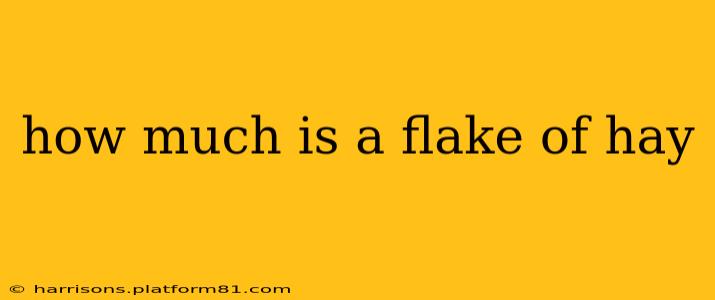How Much is a Flake of Hay? A Comprehensive Guide to Hay Pricing
The price of a flake of hay is surprisingly variable, making it difficult to give a single definitive answer. Several factors significantly influence the final cost, and understanding these factors will help you get a better grasp of what to expect when purchasing hay for your animals.
What Factors Determine the Price of a Flake of Hay?
Several key elements impact the price per flake:
-
Type of Hay: The type of grass (e.g., alfalfa, timothy, orchard grass, brome) significantly impacts cost. Alfalfa, generally considered higher quality, tends to be more expensive than other types like timothy. The nutritional content and palatability of different hays affect their market value.
-
Quality of Hay: Hay quality is determined by several factors including:
- Leafiness: Leafy hay generally contains more nutrients and is more palatable, hence commanding a higher price.
- Stage of Harvest: Hay harvested at the optimal maturity stage will have better nutrient content and therefore be more expensive.
- Moisture Content: Hay with excessive moisture can lead to spoilage and mold, impacting its quality and price. Properly cured hay with low moisture content commands a higher price due to its better quality.
- Weed Content: Hay with excessive weeds will sell for less due to lower nutritional value and potential health risks for livestock.
-
Location: Geographic location plays a crucial role. Hay prices fluctuate regionally due to factors like supply and demand, transportation costs, and local weather conditions affecting crop yields. Areas with high demand and limited supply will naturally see higher prices.
-
Supply and Demand: Like any commodity, hay prices are subject to fluctuations based on supply and demand. Droughts or other weather events that impact hay production can lead to significant price increases.
-
Packaging and Delivery: The way hay is packaged and delivered can also affect the final cost. Bales can range in size from small squares to large round bales, each impacting the price per flake. Delivery fees can also add significantly to the overall cost, particularly if the hay needs to be transported over long distances.
How Much Does a Flake of Hay Typically Cost?
It's impossible to provide an exact price without knowing the specifics mentioned above. However, as a general guideline, you might expect to pay anywhere from a few dollars to over ten dollars per flake, depending on the factors outlined above. Some sources suggest average prices ranging from $3 to $8 per flake, but this is highly dependent on your location and the type of hay.
How Can I Find the Best Price for Hay?
To find the best price for hay in your area, consider the following:
-
Contact Local Farmers and Feed Stores: Directly contacting local farmers and feed stores is the best way to get up-to-date pricing information for your area.
-
Shop Around: Compare prices from several different suppliers before making a purchase.
-
Consider Buying in Bulk: Purchasing hay in larger quantities (e.g., a whole bale) can often lead to lower prices per flake.
-
Factor in Transportation Costs: Don't forget to account for transportation costs when comparing prices.
What are the different types of hay? What are their typical prices?
The price variations between hay types are significant. Alfalfa is generally the most expensive due to its high protein and nutrient content. Timothy hay is a common choice and usually less expensive than alfalfa. Orchard grass and brome are other options with varying prices based on quality and location. It’s nearly impossible to give specific price ranges for each type without knowing the specific geographic area and current market conditions. Contact local suppliers for the most current and accurate pricing information.
In conclusion, the price of a flake of hay is highly contextual. Careful consideration of the influencing factors and diligent comparison shopping are crucial for securing the best value for your needs.
